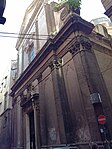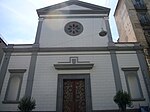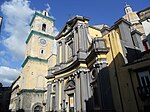Sant'Agrippino a Forcella
13th-century Roman Catholic church buildings in Italy17th-century Roman Catholic church buildings in ItalyBaroque architecture in NaplesGothic architecture in NaplesRoman Catholic churches in Naples

Sant'Agrippino a Forcella is a church located on Via Forcella in Naples, Italy. A church at the site may have been present since the fifth century, but we have documentation of a consecration during the papacy of pope Clement IV in 1265-1268. The church retains some Gothic architecture details in the apse, but the remainder of the church demonstrates the Baroque reconstructions (1758) by Nicola Tagliacozzi Canale. The exterior 14th century portal was designed by the Pisan Antonio di Chelino, pupil of Donatello.
Excerpt from the Wikipedia article Sant'Agrippino a Forcella (License: CC BY-SA 3.0, Authors, Images).Sant'Agrippino a Forcella
Via Vicaria Vecchia, Naples Pendino
Geographical coordinates (GPS) Address External links Nearby Places Show on map
Geographical coordinates (GPS)
| Latitude | Longitude |
|---|---|
| N 40.85057 ° | E 14.262085 ° |
Address
Chiesa di Sant'Agrippino a Forcella
Via Vicaria Vecchia
80138 Naples, Pendino
Campania, Italy
Open on Google Maps










